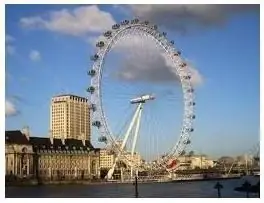- Author Harold Hamphrey [email protected].
- Public 2023-12-17 10:06.
- Last modified 2025-01-24 11:10.
The famous Potemkin Stairs in Odessa connects the city center with the Marine Station and the harbour. The giant staircase was designed by architects Francesco Boffo, Pottier and Abraham Melnikov in 1825. Engineers Morozov and Wapton built it in 1841. At that time in Odessa, the sea was washing the foot of the cliff, at the base of which the port was being built. According to the city old-timer Deribass, a steep path led to the sea, and Prince Vorontsov planned to build a staircase as a gift to his beloved wife.
The staircase was designed by engineer Wapton and is a wedge built of limestone. It is supported by wooden piles and crossed by three longitudinal and nine transverse galleries, supported at intersections by strong pillars. The stone staircase rests on massive pillars, and the galleries form spectacular arcades.
Today, the Potemkin Stairs consists of 192 steps, but initially 200 steps were laid, the rest fell asleep during the expansion of the port. The staircase is 142 meters long and includes ten flights.

The width of the base of the grand structure is 21.7 m, which is much widerits upper part, which is 12.5 m. If you look from top to bottom, then a deceptive impression is created of equal width throughout the staircase, its steps seem endless, and the parapets look parallel. When viewed from below, the Potemkin Stairs seem much longer and more majestic. The optimal angle of inclination and a large number of platforms allows the pedestrian to easily climb up.

This colossal structure became world famous thanks to Sergei Eisenstein's film "The Battleship Potemkin", filmed in 1925. The script of the film was based on the real events of the uprising of the crew of the battleship "Prince Potemkin-Tauride", which happened in 1905. When the sailors transported the body of one of the organizers of the uprising to Odessa, the workers tried to break into the port. The tsarist troops opened fire on civilians in the city. In his film, Sergei Eisenstein created a generalized picture of senseless and brutal violence. The key moment of the story was the descent of the stroller with the baby inside.

Thanks to the movie, the staircase got its modern name. It was officially called Potemkinskaya only in the 50s, after the war. On a cast-iron plate certifying the status of an architectural monument, it is said that for some time it was officially called the Seaside Stairs. It is believed that in the past it had different names, namely: Portovaya, Vorontsovskaya, Bolshaya, Boulevard, Bolshaya. But there is no confirmation of this information in the primary sources.

In 1933, the sandstone stone was replaced with pink-grey granite, and the grounds were covered with asph alt. In 1902, a funicular was built next to the stairs, connecting Primorsky Boulevard with Primorskaya Street. In the 70s it was replaced by an escalator. And in the 90s, the authorities of Odessa decided to build a new funicular. It started functioning in 2005. Every year this grandiose building turns into a place for the race "Up the Potemkin Stairs". Every year on September 2, the Potemkin Stairs becomes a large podium where a concert dedicated to the city's birthday is held.






